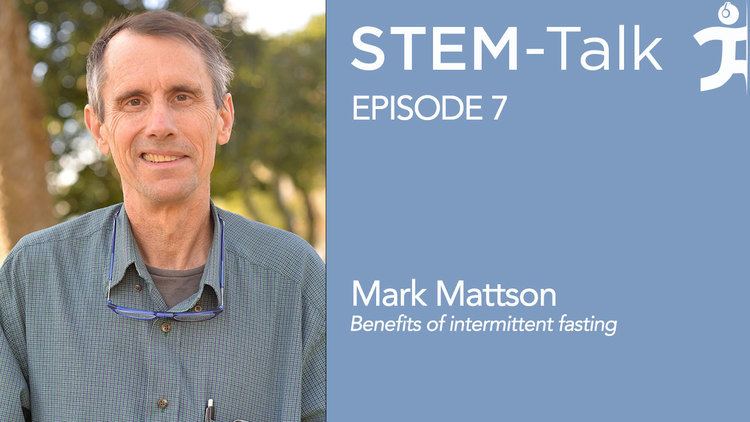Nationality American Spouse Joanne Mattson | Name Mark Mattson Fields Neurodegeneration, Ageing | |
 | ||
Institutions Johns Hopkins University School of MedicineNational Institute on Aging Intramural Research Program Alma mater Iowa State UniversityNorth Texas State UniversityUniversity of IowaColorado State University Education | ||
Why fasting bolsters brain power mark mattson at tedxjohnshopkinsuniversity
Mark P. Mattson is Chief of the Laboratory of Neurosciences at the National Institute on Aging Intramural Research Program National Institute on Aging. He is also Professor of Neuroscience at Johns Hopkins University.
Contents
- Why fasting bolsters brain power mark mattson at tedxjohnshopkinsuniversity
- Mark mattson
- Early life and education
- Career
- Awards and recognition
- Contributions to research
- Intermittent Fasting
- Personal life
- Quotes
- References

Mark mattson
Early life and education

Mark P. Mattson was born in 1957 in Rochester, Minnesota. After receiving his PhD degree from the University of Iowa, Dr. Mattson completed a postdoctoral fellowship in Developmental Neuroscience at Colorado State University. He then joined the Sanders-Brown Center on Aging and the Department of Anatomy and Neurobiology at the University of Kentucky College of Medicine as an Assistant Professor. Dr. Mattson was promoted to the rank of Associate Professor with tenure and then to Full Professor. In 2000, Dr. Mattson took the position of Chief of the Laboratory of Neurosciences at the National Institute on Aging in Baltimore, where he leads a multi-faceted research team that applies cutting-edge technologies in research aimed at understanding molecular and cellular mechanisms of brain aging and the pathogenesis of neurodegenerative disorders. He is also a Professor in the Department of Neuroscience at Johns Hopkins University School of Medicine.
Career
Dr. Mattson is considered a leader in the area of cellular and molecular mechanisms underlying neuronal plasticity and neurodegenerative disorders, and has made major contributions to understanding the pathogenesis of Alzheimer's disease, Parkinson's disease, amyotrophic lateral sclerosis and stroke, and to their prevention and treatment. He has published more than 700 peer-reviewed articles in leading journals and books, and has edited 10 books in the areas of neuronal signal transduction, neurodegenerative disorders and mechanisms of aging. Dr. Mattson has been the most highly cited neuroscientist in the world according to the ISI information database (http://www.in-cites.com/top/2006/second06-neu.html), and he has an h-index of over 180 (i.e., he has authored more than 180 articles that have each been cited at least 180 times) Profiles of Dr. Mattson have been published in numerous forums including: Science Watch (http://archive.sciencewatch.com/ana/st/alz2/11julSTAlz2Matt/). Nature Medicine (http://www.nature.com/nm/journal/v10/n4/full/nm0404-324.html).
Awards and recognition

Dr. Mattson has received many awards including the Metropolitan Life Foundation Medical Research Award, the Alzheimer's Association Zenith Award, the Jordi Folch Pi Award, the Santiago Grisolia Chair Prize, the Tovi Comet-Walerstein Science Award, and several Grass Lectureship Awards. He was elected as a Fellow of the American Association for the Advancement of Science. He is Editor-in-Chief of NeuroMolecular Medicine and Ageing Research Reviews, and has been/is a Managing or Associate Editor of the Journal of Neuroscience, Trends in Neurosciences, the Journal of Neurochemistry, the Neurobiology of Aging, and the Journal of Neuroscience Research. Dr. Mattson has served on several NIH study sections and on scientific advisory boards for many research foundations. He has trained more than 70 postdoctoral and predoctoral scientists, and has made major contributions to the education of undergraduate, graduate and medical students.
Contributions to research

Dr. Mattson established signaling pathways by which neurons respond adaptively to bioenergetic and environmental challenges in ways that bolster neuroplasticity and resistance to neurodegenerative disorders. His discoveries of the mechanisms by which intermittent fasting and exercise benefit brain and body health are being translated to disease prevention and treatment in humans.

Research by Mattson in the area of molecular and cellular mechanisms that regulate neuronal plasticity and survival, in the contexts of brain development and aging, has established a new conceptual framework for understanding the pathogenesis of neurodegenerative disorders. He showed that perturbations of cellular signaling mechanisms that regulate developmental neuroplasticity are responsible for synaptic dysfunction and cell death in neurodegenerative disorders. In particular, he has been a leader in advancing an understanding of the molecular events that destabilize cellular calcium homeostasis and ultimately cause the death of neurons in Alzheimer's disease, Parkinson's disease, ALS and stroke. Here are some specific examples of seminal findings of Dr. Mattson that represent major advances in the fields of neuroscience and neurodegenerative disorders.

In his early research Dr. Mattson discovered that the neurotransmitter glutamate, previously believed to function only at synapses, plays a key role in regulating dendrite outgrowth and synaptogenesis. He then showed that neurotrophic factors can modify the effects of neurotransmitters on neurite outgrowth, synaptogenesis and cell survival. Glutamate and neurotrophic factors exert their effects on neuronal plasticity and survival by modulating cellular calcium homeostasis. These findings revealed the molecular basis for activity-dependent regulation of neuronal plasticity. Importantly, Dr. Mattson’s discovery that neurotrophic factors such as bFGF, BDNF and IGFs can protect neurons against dysfunction and degeneration in experimental models of stroke and Alzheimer's disease led to clinical trials of neurotrophic factor delivery in patients with stroke and neurodegenerative disorders.
A major contribution to the fields of neuroscience and neurology were Dr. Mattson’s studies that elucidated mechanisms of synaptic dysfunction and degeneration in AD. He showed that amyloid beta-peptide (Abeta) induces membrane-associated oxidative stress which disrupts calcium homeostasis and renders neurons vulnerable to excitotoxicity and apoptosis. His work showed that the lipid peroxidation product 4-hydroxynonenal mediates Abeta toxicity by covalently modifying ion-motive ATPases, and glucose and glutamate transporters. He also showed that presenilin mutations endanger neurons by perturbing endoplasmic reticulum calcium regulation. His work also revealed a physiological role for the secreted form of amyloid precursor protein generated by alpha-secretase activity (sAPPalpha). He showed that sAPPalpha suppresses neuronal excitability and protects neurons against excitotoxicity by a mechanism involving activation of receptors coupled to cyclic GMP production and activation of potassium channels.
Dr. Mattson was the first to report that TNF and NF-κB can promote neuronal survival, and he went on to show that the mechanism involves up-regulation of the expression of manganese superoxide dismutase and Bcl-2, and stabilization of cellular calcium homeostasis. These provocative findings led to a 180 degree turn in the view of pro-inflammatory cytokines and NF-κB in neuronal injury by establishing that activation of NF-κB in neurons is part of an adaptive response aimed at protecting the neurons.
Discoveries made in Dr. Mattson’s laboratory led to a new view of apoptotic biochemical cascades in the physiological regulation of synaptic plasticity and structural remodeling, and introduced the neuroscience field to the concept of “synaptic apoptosis”. He showed that, by cleaving specific glutamate receptor subunits, caspases play important roles in regulating synaptic plasticity, an entirely new and unexpected function of apoptotic proteases.
A series of findings by Dr. Mattson during the 1990s and 2000s established links between diet and the pathogenesis of neurodegenerative disorders. He has shown that intermittent fasting can increase the resistance of neurons in the brain to dysfunction and degeneration in animal models of Alzheimer's, Parkinson's and Huntington's disease and stroke. The underlying mechanism was shown to involve increased production of neurotrophic factors and protein chaperones, suggesting an adaptive response of brain cells to the stress associated with intermittent fasting. Collectively, these findings provide an example of how Dr. Mattson’s basic research into the biochemistry and biology of neuronal plasticity and death has provided information that can be directly applied to improving the human condition.
Bioenergetic Challenges, Neuroplasticity and Neuroprotection: Research in Dr. Mattson’s laboratory has revealed the importance of intermittent energetic challenges such as vigorous exercise and fasting in promoting optimal brain function and resistance of the brain to injury and age-related neurodegenerative disorders. The ability of neurons to respond adaptively to mild stress is an example of hormesis, a process in which exposure of a cell or organism to a mild stress/challenge results in beneficial effects on their function and stress resistance. Dr. Mattson found that neurons can respond to energetic challenges by increasing their production of: neurotrophic factors important for learning and memory, and neurogenesis (the production of new neurons from stem cells; DNA repair enzymes that prevent the accumulation of mutations; and antioxidant enzymes that enable cells to squelch free radicals. His laboratory also discovered that bioenergetics challenges such as exercise can increase the number of mitochondria in neurons and can enhance the health of the mitochondria. In related studies, several drugs that induce mild stress on mitochondria were found to be beneficial in animal models of stroke.
Dr. Mattson’s work has revealed mechanisms by which diabetes adversely affects hippocampal plasticity and cognitive function. He showed that, in both insulin-deficient rats and insulin-resistant mice, diabetes impairs hippocampus-dependent memory, perforant path synaptic plasticity and adult neurogenesis, and the adrenal steroid corticosterone contributes to these adverse effects. Changes in hippocampal plasticity and function in both models were reversed when normal physiological levels of corticosterone were maintained, suggesting that cognitive impairment in diabetes may result from glucocorticoid-mediated deficits in neurogenesis and synaptic plasticity. In a related study, Mattson showed that rats fed with a high-fat, high-glucose diet supplemented with fructose corn syrup exhibit alterations in energy and lipid metabolism similar to clinical diabetes, with elevated fasting glucose and increased cholesterol and triglycerides. Rats maintained on this diet for 8 months exhibited impaired spatial learning ability, reduced hippocampal dendritic spine density, and reduced long-term potentiation at Schaffer collateral—CA1 synapses. These changes occurred concurrently with reductions in levels of BDNF in the hippocampus. Dr. Mattson also investigated whether manipulations that enhance neurotrophin levels will also restore neuronal structure and function in diabetes. He found that running wheel activity, caloric restriction, or the combination of the two treatments increased levels of BDNF in the hippocampus of diabetic mice. Enhancement of hippocampal BDNF was accompanied by increases in dendritic spine density on the secondary and tertiary dendrites of dentate granule neurons. These studies suggest that diabetes exerts detrimental effects on hippocampal structure, and that this state can be attenuated by increasing energy expenditure and decreasing energy intake. The implications of these findings for cognitive aging are clear – dietary moderation and regular exercise will enhance cognitive function.
The key roles of toll-like receptors (TLRs) as mediators of the detection and responses of immune cells to invading pathogens are well known. However, Dr. Mattson recently discovered that neurons also express a subset of TLRs and that their activation promotes neuronal degeneration in experimental models of stroke and AD He has also provided evidence that toll-like receptors play roles in regulating the processes of neurogenesis and neurite outgrowth, suggesting roles in neuronal plasticity. TLR2 and TLR4 levels are increased in cerebral cortical neurons in response to ischemia/reperfusion injury, and the amount of brain damage and neurological deficits caused by a stroke are significantly less in mice deficient in TLR2 or -4 compared with WT control mice. Mattson found that TLR4 expression increases in neurons when exposed to Abeta or the lipid peroxidation product 4-hydroxynonenal (HNE). Neuronal apoptosis triggered by Abeta and HNE is mediated by jun N-terminal kinase (JNK); neurons from TLR4 mutant mice exhibit reduced JNK and caspase-3 activation and were protected against apoptosis induced by Abeta and HNE. Levels of TLR4 are decreased in inferior parietal cortex tissue specimens from end-stage AD patients compared to aged-matched control subjects, possibly as the result of loss of neurons expressing TLR4. These findings suggest that TLR4 signaling increases the vulnerability of neurons to Abeta and oxidative stress in AD, and identify TLR4 as a potential therapeutic target for stroke and AD.
Glucagon-like peptide-1 (GLP-1) is an endogenous insulinotropic peptide secreted from the gastrointestinal tract in response to food intake. It enhances pancreatic islet beta-cell proliferation and glucose-dependent insulin secretion, and lowers blood glucose and food intake in patients with type 2 diabetes mellitus (T2DM). A long-acting GLP-1 receptor (GLP-1R) agonist, Exenatide, is the first of this new class of antihyperglycemia drugs approved by the FDA to treat T2DM. Mattson and his colleagues at the National Institute on Aging have shown that GLP-1Rs are expressed in neurons where they are coupled to the cAMP second messenger pathway resulting in neurotrophic actions. For example, he showed that Exenatide can protect neurons from being damaged and killed by Abeta. Administration of Exenatide reduced brain damage and improved functional outcome in a transient middle cerebral artery occlusion stroke model, and also protected dopaminergic neurons against degeneration, preserved dopamine levels, and improved motor function in the 1-methyl-4-phenyl-1,2,3,6-tetrahydropyridine (MPTP) mouse model of Parkinson's disease. Moreover, Exenatide treatment ameliorated abnormalities in peripheral glucose regulation and suppressed cellular pathology in both brain and pancreas in a mouse model of Huntington's disease. The treatment also improved motor function and extended the survival time of the Huntington's disease mice. Because Exenatide improves glucose regulation and exerts direct neuroprotective actions on neurons in the brain, it and related drugs are being tested in patients with mild cognitive impairment and Alzheimer's disease.
Intermittent Fasting
Dr. Mattson’s research on animal models and human subjects has resulted in the widespread adoption of intermittent fasting as an intervention to optimize health and reduce the risk of many major chronic diseases including obesity, diabetes, cancer, asthma and other inflammatory disorders, cardiovascular disease and neurodegenerative disorders.
Animal studies performed in Dr. Mattson’s Laboratory showed that intermittent fasting has profound beneficial effects on the body and brain including: 1) Improved glucose regulation; 2) Loss of abdominal fat with maintenance of muscle mass; 3) Reduced blood pressure and heart rate, and increased heart rate variability (similar to what occurs in trained endurance athletes; 4) Improved learning and memory and motor function; 5) Protection of neurons in the brain against dysfunction and degeneration in animal models of Alzheimer's disease, Parkinson's disease, stroke and Huntington's disease. He further discovered that intermittent fasting is beneficial for health because it imposes a challenge to cells, and those cells respond adaptively by enhancing their ability to cope with stress and resist disease.
After publishing the results of two studies documenting beneficial effects of intermittent fasting in human subjects, one in asthma patients (in collaboration with Dr. James Johnson at LSU Medical Center) and another in women at risk for breast cancer (in collaboration with Dr. Michelle Harvie at the University of Manchester), media coverage of Dr. Mattson’s research led to a BBC documentary and a subsequent book by Dr. Michael Mosley which have informed the public throughout Europe and North America of the health benefits of intermittent fasting. In particular, a diet called the 5:2 diet, based on the studies of Drs. Harvie and Mattson has become widely popular. A person on the 5:2 diet eats normal amounts of healthy food 5 days each week and eats only one moderate size (500-600 calorie) meal 2 days each week. For many, this diet has proven easy to implement and maintain.
Phytochemical Hormesis: In 2006 Dr. Mattson proposed that the reason that vegetables, fruits, tea and coffee can improve brain health is that they contain ‘noxious’ chemicals that are produced by the plants to protect themselves from being eaten by insects and other organisms. {Mattson, M. P. and A. Cheng (2006) Neurohormetic phytochemicals: low dose toxins that induce adaptive neuronal stress responses. Trends Neurosci. 29: 632-639} Such phytochemicals, which are classified as antifeedants or natural pesticides, trigger adaptive stress responses in brain cells which can improve brain function and may increase the resistance of neurons to injury and age-related neurodegenerative disorders such as Alzheimer’s disease and Parkinson’s disease. Dr. Mattson recently published an article in Scientific American that describes the evolutionary basis, molecular mechanisms and dietary implications of what he has termed ‘phytochemical hormesis’
Mental Pattern Processing: A fundamental question in philosophy and neuroscience is why and how humans have greatly surpassed other species in their abilities to reason, communicate and engage in abstract thought. In 2014 Dr. Mattson published an article entitled “Superior Pattern Processing is the Essence of the Evolved Human Brain” in which he proposed that superior mental processing of patterns is the fundamental basis of all advanced capabilities of the human brain including intelligence, imagination, invention, language and the belief in imaginary entities such as gods and ghosts. The expansion of the cerebral cortex during human evolution involved mostly brain regions such as the visual association cortex and prefrontal cortex that function to rapidly process visual images and make decisions accordingly. Patterns, be they real or imagined, are reinforced by emotional and social experiences, indoctrination and even psychedelic drugs. The abnormal brain function and behaviors that occur in cognitive and psychiatric disorders result from impaired or aberrant pattern processing. Dr. Mattson’s theory has important implications for understanding human intelligence, creativity and imagination, and for the development of novel approaches for reducing irrational decisions and destructive behaviors that continue to persist in individuals and radical groups throughout the world.
Personal life
Dr. Mattson lives with his wife, Joanne Mattson and is father to two children, Elliot and Emma. In his spare time, he pursues trail running, mountain biking and off-road motorcycling. Having been taught by his father DeWayne, Mark learned how to train and drive standardbred race horses (trotters and pacers), and competed on race tracks in Minnesota, Wisconsin, Iowa and Michigan during the 1970s and 1980s. In the past, he also competed as a distance runner, and was a cross country running coach at Patterson Mill High School in Bel Air, Maryland. Additionally, he is a qualified Master Gardener and enjoys animal husbandry.
Quotes
“Superior pattern processing is the essence of the evolved human brain.”
“Minds are opened by wonder and closed by belief.”
“The human brain is particularly adept at imagination, an ability responsible for both understanding and escaping reality.”
“Challenges prolong life, while complacency hastens death.”
“Nerve cells possess an innate ability to respond adaptively to intermittent challenges in ways that help them perform optimally and counteract the adversities of aging, thereby forestalling Alzheimer’s and Parkinson’s diseases.”
"Mental pattern processing is both necessary and sufficient for consciousness."
“Imagination is an advanced form of mental pattern processing that enables the formulation and testing of hypotheses, which is required to establish the truth and to predict future outcomes. Unfortunately, many people stop at the imagination step and so never understand and embrace the truth.”
“A lack of understanding of the distinction between probability and possibility is an aspect of scientific illiteracy that is highly consequential.”
“The unique ability of humans to interrogate and understand reality should be pursued assiduously and with sagacity.”
“Trail running is a quintessential human pleasure.”
